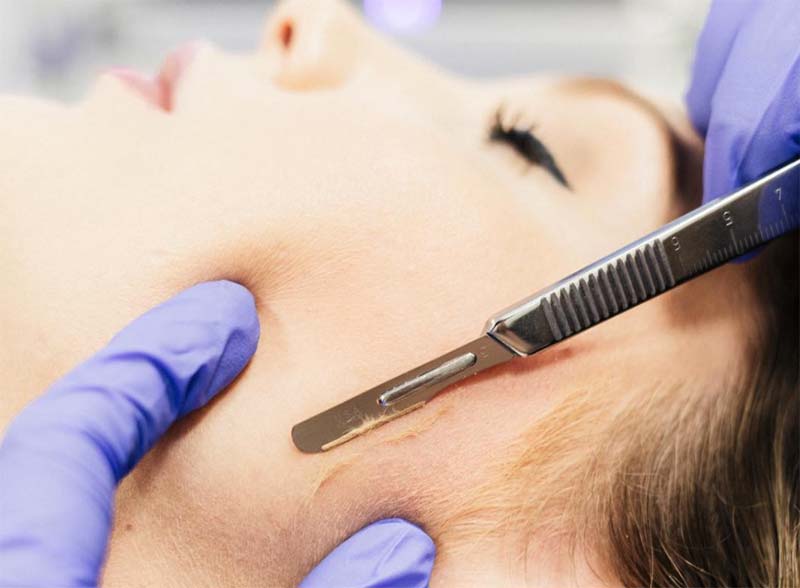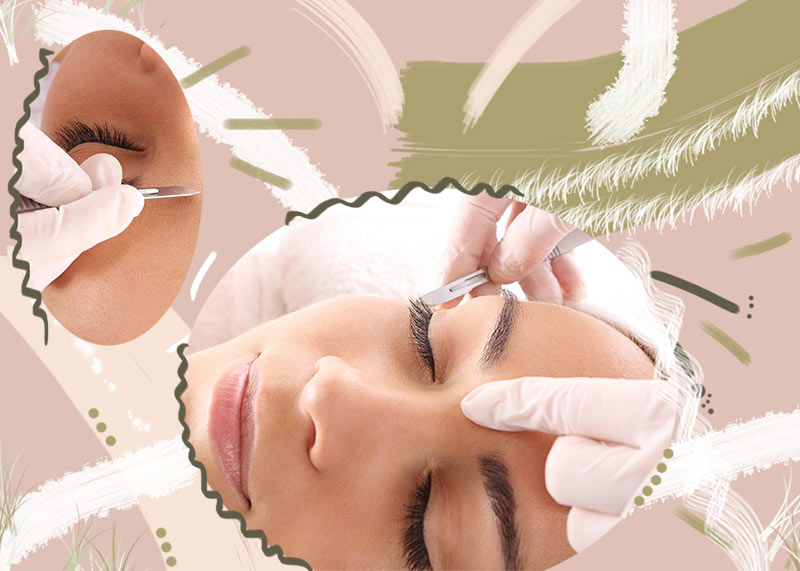Dermaplaning is an old skin care trick that is making a comeback, and I am going to tell you everything there is to know about it – what dermaplaning is, why you should consider giving it a try, how dermaplaning is done at home and at the salon (and how to choose which option is best for you!), as well as any other details you might need. If you have any concerns, I suspect this article will not answer them. Enjoy!
In this article:
- What Is Dermaplaning?
- Why Should I Be Dermaplaning?
- How Is Dermaplaning Done?
- Should I Be Dermaplaning at Home Or at a Salon?
- How Much Does In-Salon Dermaplaning Cost?
- Can Anyone Undergo Dermaplaning?
- Does Dermaplaning Hurt?
- Will My Hair Grow Back Thicker after Dermaplaning?
- Are There Any Reasons Not to Dermaplane?
- Some Words of Warning and a Few Suggestions
- How Often Should I Do Dermaplaning?
What Is Dermaplaning?
Dermaplaning is the act of using a razor blade (yes, like the one you would use to shave) in order to exfoliate the skin. It is a type of physical exfoliation, much like using a scrub or doing a microdermabrasion. While hair removal is not the purpose of dermaplaning, dermaplaning still removes the hair.
Why Should I Be Dermaplaning?
The most frequent remark people make after they start dermaplaning is that their makeup seems to go on much better. Regardless of whether it is because of the exfoliation, or because all of those tiny little hairs are gone (it’s probably both), makeup seems to go on more smoothly, blend more easily, and last longer.
As with an exfoliation, dermaplaning removes the top layers of dead skin, and leaves behind younger, fresher, and brighter skin. The act of exfoliation also helps to stimulate cell renewal, so it is definitely beneficial in the long term.
Dermaplaning also removes a lot of debris that prevents skincare serums and creams from adequately penetrating into the skin. Regular exfoliation, when paired with the appropriate skincare routine, can reduce fine lines, fade hyperpigmentation and acne scars, and overall improve the skin’s texture.
How Is Dermaplaning Done?
Technically, the use of any razor blade to shave facial skin will count as dermaplaning, but there are some general guidelines and best practices, to ensure safety and efficacy. You can have dermaplaning at a salon, or at home. Naturally, there will be some differences between having it done by a professional, or doing it yourself.
Dermaplaning at a Salon
- The aesthetician starts by ensuring that all tools are perfectly sterile – especially the blade.
- In a salon, dermaplaning is commonly done with a sterile 10-gauge surgical scalpel, which is sharper and requires more careful handling than your average razor blade.
- The client’s skin is thoroughly cleansed and dried.
- The aesthetician will usually begin from the lower part of the face, and work their way up.
- They will hold a small section of skin taut between their fingers, and then pass the razor blade over it in upwards motions, going against the direction of hair growth.
- Once they have passed all over the skin, removing all hair and dead cells, they will either continue the treatment with further exfoliation, or finish off with a soothing mask or serums and creams.
Dermaplaning at Home
For at-home dermaplaning, there are two routes you could go. You can purchase a fancy at-home dermaplaning system, like the DermaFlash Facial Exfoliating Device (it’ll set you back $189, at Nordstrom), but many at-home dermaplaners swear by simple eyebrow razors, like the simple ones from Sephora.
- Start with cleansed and thoroughly dried skin. A gentle face wash like the Fresh Soy Face Cleanser, from Sephora, should do the trick.
- Regardless which tool you’ll be using, make sure it is adequately sterilized.
- Regardless of where you start, choose a starting point. Use your thumb and index finger to pull about an inch or two of you skin taut. This will keep your skin tight, and prevent accidental cuts.
- Begin running the blade over your skin at a 45-degree angle.
- Pass over the skin in short strokes. Since you are doing it yourself, you will have more control shaving in either downward strokes, or from the outside of the face inwards.
- Do not go over any areas of your skin more than once.
- Finish off with a soothing toner, and any serums or face moisturizers you normally use.
Should I Be Dermaplaning at Home Or at a Salon?
Since dermaplaning is a fairly low-impact treatment, doing it by yourself at home is perfectly safe. However, at a salon you get the extra benefits of seeing an aesthetician: years of training and skin knowledge, additional treatments, and a much more experienced touch.
In-salon dermaplaning is definitely more thorough, since the aesthetician can use a sharper tool at a much more controlled angle. An aesthetician will also be dermaplaning your face against the direction of hair growth, which will give you a deeper exfoliation and closer shave. This would be very difficult for someone to do on themselves at home.
At home, however, you can still achieve wonderful results. You just have to be very careful – ensure everything you use is carefully cleaned and sanitized, and always hold your blade at a 45-degree angle.
How Much Does In-Salon Dermaplaning Cost?
A dermaplaning session takes about 30 minutes to perform and costs between $40 and $150, depending on the region, length of treatment, additional masks, and whether it is done be an aesthetician, nurse, or licensed dermatologist.
Can Anyone Undergo Dermaplaning?
With the exception of those with active acne (i.e. pustules and pimples that could be broken by the blade), anyone, including pregnant women, can have their skin exfoliated using this method. Dermaplaning is gentle, and does not require the use of any chemicals.
Those who are prone to ingrown hairs or have extremely sensitive skin might choose to avoid this treatment.
Does Dermaplaning Hurt?
Not at all! Dermaplaning only removes surface dead skin, so it just feels like a light, painless scraping, akin to shaving one’s legs. If it does hurt, you are probably doing it wrong.
Will My Hair Grow Back Thicker after Dermaplaning?
When we cut the hair with a razor, we remove its tapered end, leaving it flat. Once the hair grows out, this means that it might seem a little thicker or coarser.
In reality, the hair is growing back in the exact same size, length, and density that it had before, but it might just momentarily stand out as it’s growing back. In practice, this tends to be more of an issue with darker hairs, while vellus hairs (a.k.a. peach fuzz) don’t grow back in a noticeable manner.

Are There Any Reasons Not to Dermaplane?
Well… as with any new skincare product or procedure, you run the risk of irritating your skin. It is hard to predict how the skin will react to new experiences.
Additionally, if you are thinking of dermaplaning at home, seriously consider how steady your hands are – you don’t want to risk nicking yourself.
For some people, other facial treatments, like a chemical peel or a microdermabrasion, might be more appropriate. Consider all of the possible treatments, and have a serious consultation with your aesthetician, before undergoing any facial treatment.
However, for the most part, I can’t see a reason why dermaplaning could hurt any more than any other type of exfoliation. If you are confident in your aesthetician or in your own skills, go ahead and give it a try!
Some Words of Warning and a Few Suggestions
- Do not do dermaplaning one day before or one day after doing a chemical peel. Wait longer before and after doing stronger resurfacing treatments.
- Be extra careful to wear a sunscreen with at least a 30 SPF, because dermaplaning (like almost all other exfoliation methods) leaves your skin more sensitive to sun exposure.
- If your skin is very prone to ingrown hairs and you still want to try dermaplaning, try a BHA serum 24 hours after your treatment (and no sooner!). It’ll prevent your pores from becoming clogged, and allow the hair to regrow more smoothly. This Paula’s Choice BHA from Nordstrom is a classic option.
How Often Should I Do Dermaplaning?
Since in-salon dermaplaning is more intense, you want to wait at least 3 weeks in between sessions, to allow your skin enough time to heal and regenerate. If you are dermaplaning at home, you might be able to do it even once a week, depending on how gentle you are, and whether you also use acids to exfoliate your skin.
Now that you know all the details about dermaplaning, are you going to give it a try? Would you go to a salon, or try it at home? Have you tried it before? How did you like it? Let us know!
Photos via @the_aesthetician, Instagram





